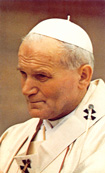|
 Distribution
over time Distribution
over time
 38. The Rosary can be recited
in full every day, and there are those who most laudably do so.
In this way it fills with prayer the days of many a contemplative,
or keeps company with the sick and the elderly who have abundant time at
their disposal. Yet it is clear – and this applies all the more if the new series
of mysteria lucis is included – that many people will not be able to recite
more than a part of the Rosary, according to a certain weekly pattern.
This weekly distribution has the effect of giving the different days of the week
a certain spiritual "colour", by analogy with the way in which the Liturgy
colours the different seasons of the liturgical year. 38. The Rosary can be recited
in full every day, and there are those who most laudably do so.
In this way it fills with prayer the days of many a contemplative,
or keeps company with the sick and the elderly who have abundant time at
their disposal. Yet it is clear – and this applies all the more if the new series
of mysteria lucis is included – that many people will not be able to recite
more than a part of the Rosary, according to a certain weekly pattern.
This weekly distribution has the effect of giving the different days of the week
a certain spiritual "colour", by analogy with the way in which the Liturgy
colours the different seasons of the liturgical year.
 According
to current practice, Monday and Thursday are dedicated to the "joyful mysteries",
Tuesday and Friday to the "sorrowful mysteries", and Wednesday,
Saturday and Sunday to the "glorious mysteries". Where might
the "mysteries of light" be inserted? If we consider that
the "glorious mysteries" are said on both Saturday and Sunday,
and that Saturday has always had a special Marian flavour,
the second weekly meditation on the "joyful mysteries",
mysteries in which Mary's presence is especially pronounced, could be moved to Saturday.
Thursday would then be free for meditating on the "mysteries of light". According
to current practice, Monday and Thursday are dedicated to the "joyful mysteries",
Tuesday and Friday to the "sorrowful mysteries", and Wednesday,
Saturday and Sunday to the "glorious mysteries". Where might
the "mysteries of light" be inserted? If we consider that
the "glorious mysteries" are said on both Saturday and Sunday,
and that Saturday has always had a special Marian flavour,
the second weekly meditation on the "joyful mysteries",
mysteries in which Mary's presence is especially pronounced, could be moved to Saturday.
Thursday would then be free for meditating on the "mysteries of light".
 This indication
is not intended to limit a rightful freedom in personal and community prayer,
where account needs to be taken of spiritual and pastoral needs
and of the occurrence of particular liturgical celebrations which might call
for suitable adaptations. What is really important is that the Rosary
should always be seen and experienced as a path of contemplation. In the Rosary,
in a way similar to what takes place in the Liturgy, the Christian week, centred
on Sunday, the day of Resurrection, becomes a journey through the mysteries of
the life of Christ, and he is revealed in the lives of his disciples as the Lord
of time and of history. This indication
is not intended to limit a rightful freedom in personal and community prayer,
where account needs to be taken of spiritual and pastoral needs
and of the occurrence of particular liturgical celebrations which might call
for suitable adaptations. What is really important is that the Rosary
should always be seen and experienced as a path of contemplation. In the Rosary,
in a way similar to what takes place in the Liturgy, the Christian week, centred
on Sunday, the day of Resurrection, becomes a journey through the mysteries of
the life of Christ, and he is revealed in the lives of his disciples as the Lord
of time and of history.
|

